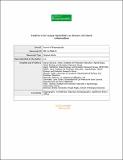Por favor, use este identificador para citar o enlazar a este item:
http://hdl.handle.net/10261/184958COMPARTIR / EXPORTAR:
 SHARE SHARE
 CORE
BASE CORE
BASE
|
|
| Visualizar otros formatos: MARC | Dublin Core | RDF | ORE | MODS | METS | DIDL | DATACITE | |

| Título: | Evidence for mega-landslides as drivers of island colonization |
Autor: | García-Olivares, Víctor CSIC; López, Heriberto CSIC ORCID ; Patiño, Jairo CSIC ORCID ; Álvarez, Nadir; Machado, Antonio; Carracedo, Juan Carlos CSIC ORCID; Soler, Vicente CSIC ORCID; Emerson, Brent C. CSIC ORCID | Palabras clave: | Phylogeography Biogeography Rafting Long‐distance dispersal Landslide Invertebrate Equilibrium theory Canary Islands |
Fecha de publicación: | may-2017 | Editor: | Blackwell Publishing | Citación: | Journal of Biogeography 44(5): 1053-1064 (2017) | Resumen: | [Aim] How non-dispersive taxa colonize islands is generalized as being by wind, or rafting, with the implicit assumption that such events involve one (wind) or a few (rafting) individuals. However, because of the evolutionary time-scale for colonization events, the fit of individual species to a conceptual model of wind or rafting is difficult to assess. Here, we describe an alternative testable geological model for inter-island colonization that can result in larger effective founding population sizes than traditionally accepted colonization mechanisms. We then test for the fit of genetic data to this model using weevils from the Laparocerus tessellatus species complex. [Location] Canary Islands. Methods: Using a combination of geological data for the Canary Islands, and mtDNA data from a weevil radiation within the Canary Islands, we test three species-level predictions for mega-landslides as drivers of oceanic rafting between islands and subsequent speciation: (1) colonization should involve multiple female lineages, (2) founding lineages should have a common geographical origin, consistent with a mega-landslide event, and (3) colonization direction should be consistent with ocean currents. [Results] Both individual-level and population-level analyses support a mega-landslide event as the driver of colonization from the island of Tenerife to La Palma. At least four female lineages colonized La Palma from Tenerife, with the geographical range of ancestral sequences to these four lineages describing the limits of the La Orotava mega-landslide in Tenerife. [Main conclusions] In the context of island biogeographical theory, mega-landslides may be an important driver of colonization, and subsequent lineage diversification. They provide a framework for hypothesis testing using genetic data from species, or closely related species, with ranges that encompass landslides and potential areas of colonization. | Versión del editor: | https://doi.org/10.1111/jbi.12961 | URI: | http://hdl.handle.net/10261/184958 | DOI: | 10.1111/jbi.12961 | ISSN: | 0305-0270 | E-ISSN: | 1365-2699 |
| Aparece en las colecciones: | (IPNA) Artículos |
Ficheros en este ítem:
| Fichero | Descripción | Tamaño | Formato | |
|---|---|---|---|---|
| Evidence_Olivares_Preprint_Art2017.pdf | 19,7 MB | Adobe PDF |  Visualizar/Abrir |
CORE Recommender
SCOPUSTM
Citations
18
checked on 11-abr-2024
WEB OF SCIENCETM
Citations
21
checked on 21-feb-2024
Page view(s)
391
checked on 18-abr-2024
Download(s)
373
checked on 18-abr-2024
Google ScholarTM
Check
Altmetric
Altmetric
NOTA: Los ítems de Digital.CSIC están protegidos por copyright, con todos los derechos reservados, a menos que se indique lo contrario.
